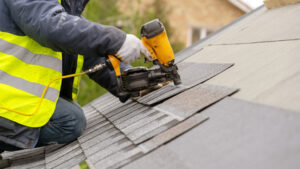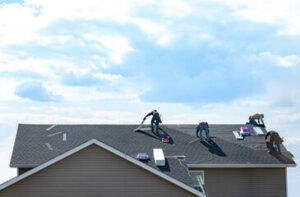Roof Company Baton Rouge can fix a leaky roof and replace missing shingles. They can also help with roof inspections and provide warranties for their work. They will also handle any extra issues that might occur during the repair process.

Getting customers for your roofing business can be difficult, but there are many ways to market your services. For example, you can put up fliers and pamphlets at local homes. You can also try door-to-door salesmanship.
Roofing is a rugged industry in which accidents and injuries can occur. For this reason, you need to have insurance coverage to protect yourself and your customers. You can obtain general liability and workers’ compensation insurance for your business. You should also have vehicle insurance and equipment insurance for your work vehicles.
The cost of doing business with a Roof Company depends on the type of roof and the complexity of its design. For example, if the roof is a walker roof or requires a steep ladder, it will be more expensive to install than a flat roof. In addition, the type of shingles and underlayment used can significantly impact the final cost of the project.
You should also consider the cost of marketing and advertising your business. A good logo, a professional website, and a well-signed vehicle are all important factors in attracting potential clients. You should also get a merchant account so you can accept credit and debit cards.
If you’re starting a roofing business, it’s crucial to have a clear plan for your business goals and budget. You can do this by meeting with a qualified accountant or mentor who can help you determine your startup costs and prepare financial statements. You should also register your business entity with the state or local government. This will affect how much you pay in taxes and may allow for more small business tax deductions.
Warranty
When you are choosing a roof company, make sure to ask about their warranty. The length and type of coverage vary from one manufacturer to another, but you should choose a contractor with a comprehensive manufacturer and workmanship warranty. This will give you peace of mind that your investment is protected for many years to come.
A roofing warranty can protect you from costly repairs and potential liability issues, but it’s important to understand what’s covered. The two main types of roof warranties are a manufacturer’s material warranty and a roofing contractor’s workmanship warranty. The manufacturer’s material warranty covers the materials, while the contractor’s workmanship warranty covers the installation process. Some companies also offer a combined manufacturer and contractor’s warranty, which can last up to 30 years.
The warranty offered by a roof company can cover a wide range of issues, including leaks, mold growth and structural damage. It can even pay for a complete roof replacement. However, it does not cover natural disasters or acts of God, such as fire, lightning, hail, high winds, or earthquakes. If you live in an area with frequent storms, consider adding a warranty that covers the cost of replacing damaged shingles or tiles.
Manufacturer warranty coverage typically varies from one company to the next, but most will cover the cost of replacement of defective shingle or metal materials for a period of time after the initial installation. These policies can be extended or purchased at an additional cost for increased coverage.
Some manufacturers also offer a no-dollar limit (NDL) warranty, which will replace your roof if it suffers from any defects. A roof warranty is a great way to protect your investment and ensure that you get the best possible service from your roofing company. Be sure to read the fine print and follow all of the rules, as violating a warranty may void it. Common violations include failing to set a calendar reminder for regular inspections, using a different contractor, or not registering your roof warranty within the required time frame. These errors can result in a loss of valuable coverage and expensive repairs.
Reputation
In the roofing business it’s very important to have a good reputation. A good reputation is the backbone of a company and it can be a huge factor when you’re looking for a roofing company. Look for a company that has a professional website and branding. Pay attention to how quickly you get a response when you call, and how long it takes for the roofer to come out and inspect your property and give you a quote. Another great indicator is to see if the roofing company has insurance. Insurance is a must for any business as it helps to protect the company and customers from damage and injury.
Experience
A roof company is a business that does repairs and replacements of roofing systems. It can be a sole proprietorship, partnership, corporation or limited liability company (LLC). A contractor will need a business license for the area in which they intend to operate and insurance coverage to protect against accidents and property damage.
Choosing a roofing company with experience is critical to the success of the project. Those with experience have a better understanding of the re-roofing process, and can provide a detailed estimate that includes all materials needed, as well as labor costs. They can also identify and resolve any problems that may arise during the re-roofing process. In addition, they can address any special requests by the homeowner and keep the job on schedule.
In addition to being experienced, a good roofing company should be licensed and insured. Inquire about the type of insurance that they have, including general liability and workers’ compensation. It’s important to have the right insurance, because a roofer can be injured on the job. This can result in lost income, medical bills and lawsuits.
When selecting a roofing company, ask for references and reviews from past clients. Look for companies with a high number of positive reviews and no complaints. You should also check out their reputation on Google and other online directories. Ideally, the roofing company should be locally owned and operated.
A reliable roofing company should be able to offer a variety of payment options. Some of these include cash and checks, but most prefer to accept credit cards. This allows them to attract a wider audience and increase their sales. Some roofing contractors also partner with financing companies to offer preapproved loans.
Another way to market a roofing company is to advertise through local radio and television. Some even use billboards to promote their services. Another great marketing tool is to offer a free on-site inspection and estimate. This can be a great way to get new customers, especially when the homeowners are planning to sell their home in the future. It is also important to create a website that shows photos of previous jobs.




